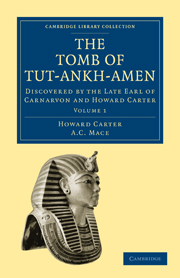Book contents
- Frontmatter
- Preface
- Contents
- LIST OF PLATES
- INTRODUCTION. BIOGRAPHICAL SKETCH OF THE LATE LORD CARNARVON
- CHAPTER 1 THE KING AND THE QUEEN
- CHAPTER 2 THE VALLEY AND THE TOMB
- CHAPTER 3 THE VALLEY IN MODERN TIMES
- CHAPTER 4 OUR PREFATORY WORK AT THEBES
- CHAPTER 5 THE FINDING OF THE TOMB
- CHAPTER 6 A PRELIMINARY INVESTIGATION
- CHAPTER 7 A SURVEY OF THE ANTECAMBER
- CHAPTER 8 CLEARING THE ANTECHAMBER
- CHAPTER 9 VISITORS AND THE PRESS
- CHAPTER 10 WORK IN THE LABORATORY
- CHAPTER 11 THE OPENING OF THE SEALED DOOR
- APPENDIX
- INDEX
- Plate section
- Plate section
CHAPTER 11 - THE OPENING OF THE SEALED DOOR
Published online by Cambridge University Press: 07 October 2011
- Frontmatter
- Preface
- Contents
- LIST OF PLATES
- INTRODUCTION. BIOGRAPHICAL SKETCH OF THE LATE LORD CARNARVON
- CHAPTER 1 THE KING AND THE QUEEN
- CHAPTER 2 THE VALLEY AND THE TOMB
- CHAPTER 3 THE VALLEY IN MODERN TIMES
- CHAPTER 4 OUR PREFATORY WORK AT THEBES
- CHAPTER 5 THE FINDING OF THE TOMB
- CHAPTER 6 A PRELIMINARY INVESTIGATION
- CHAPTER 7 A SURVEY OF THE ANTECAMBER
- CHAPTER 8 CLEARING THE ANTECHAMBER
- CHAPTER 9 VISITORS AND THE PRESS
- CHAPTER 10 WORK IN THE LABORATORY
- CHAPTER 11 THE OPENING OF THE SEALED DOOR
- APPENDIX
- INDEX
- Plate section
- Plate section
Summary
By the middle of February our work in the Antechamber was finished. With the exception of the two sentinel statues, left for a special reason, all its contents had been removed to the laboratory, every inch of its floor had been swept and sifted for the last bead or fallen piece of inlay, and it now stood bare and empty. We were ready at last to penetrate the mystery of the sealed door.
Friday, the 17th, was the day appointed, and at two o'clock those who were to be privileged to witness the ceremony met by appointment above the tomb. They included Lord Carnarvon, Lady Evelyn Herbert, H.E. Abd el Halim Pasha Suleman, Minister of Public Works, M. Lacau, Director-General of the Service of Antiquities, Sir William Garstin, Sir Charles Cust, Mr. Lythgoe, Curator of the Egyptian Department of the Metropolitan Museum, New York, Professor Breasted, Dr. Alan Gardiner, Mr. Winlock, the Hon. Mervyn Herbert, the Hon. Richard Bethell, Mr. Engelbach, Chief Inspector of the Department of Antiquities, three Egyptian inspectors of the Department of Antiquities, the representative of the Government Press Bureau, and the members of the staff—about twenty persons in all. By a quarter past two the whole company had assembled, so we removed our coats and filed down the sloping passage into the tomb.
In the Antechamber everything was prepared and ready, and to those who had not visited it since the original opening of the tomb it must have presented a strange sight.
- Type
- Chapter
- Information
- The Tomb of Tut-Ankh-AmenDiscovered by the Late Earl of Carnarvon and Howard Carter, pp. 178 - 188Publisher: Cambridge University PressPrint publication year: 2010First published in: 1923



